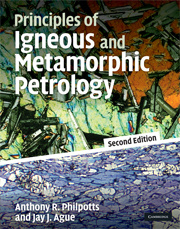Book contents
- Frontmatter
- Contents
- Preface
- Acknowledgments
- List of units
- 1 Introduction
- 2 Physical properties of magma
- 3 Intrusion of magma
- 4 Forms of igneous bodies
- 5 Cooling of igneous bodies and other diffusion processes
- 6 Classification of igneous rocks
- 7 Introduction to thermodynamics
- 8 Free energy and phase equilibria
- 9 Thermodynamics of solutions
- 10 Phase equilibria in igneous systems
- 11 Effects of volatiles on melt equilibria
- 12 Crystal growth
- 13 Isotope geochemistry related to petrology
- 14 Magmatic processes
- 15 Igneous rock associations
- 16 Metamorphism and metamorphic facies
- 17 Deformation and textures of metamorphic rocks
- 18 Graphical analysis of metamorphic mineral assemblages
- 19 Geothermometry, geobarometry, and mineral reactions among solid solutions
- 20 Mineral reactions involving H2O and CO2
- 21 Material transport during metamorphism
- 22 Pressure–temperature–time paths and heat transfer during metamorphism
- 23 Origin of rocks
- Answers to selected numerical problems
- References
- Index
6 - Classification of igneous rocks
- Frontmatter
- Contents
- Preface
- Acknowledgments
- List of units
- 1 Introduction
- 2 Physical properties of magma
- 3 Intrusion of magma
- 4 Forms of igneous bodies
- 5 Cooling of igneous bodies and other diffusion processes
- 6 Classification of igneous rocks
- 7 Introduction to thermodynamics
- 8 Free energy and phase equilibria
- 9 Thermodynamics of solutions
- 10 Phase equilibria in igneous systems
- 11 Effects of volatiles on melt equilibria
- 12 Crystal growth
- 13 Isotope geochemistry related to petrology
- 14 Magmatic processes
- 15 Igneous rock associations
- 16 Metamorphism and metamorphic facies
- 17 Deformation and textures of metamorphic rocks
- 18 Graphical analysis of metamorphic mineral assemblages
- 19 Geothermometry, geobarometry, and mineral reactions among solid solutions
- 20 Mineral reactions involving H2O and CO2
- 21 Material transport during metamorphism
- 22 Pressure–temperature–time paths and heat transfer during metamorphism
- 23 Origin of rocks
- Answers to selected numerical problems
- References
- Index
Summary
INTRODUCTION
Much has been written about the classification of igneous rocks, and many older petrology texts devote lengthy chapters to this topic. Historically, in any of the natural sciences, classification is extremely important because it forms the basis on which the science grows. At first, definitions are necessary simply to permit communication. The organizing and systematizing of the defined quantities then lead to the development of genetic models that attempt to explain the apparent order revealed by the classification. At this stage, modification of some of the original definitions may improve the classification by simplifying the genetic models. Through such reiterations it is hoped the order in classifications can be made to match more closely the order that presumably exists in nature. Some classifications have approached this goal more closely than others, whereas some have completely failed and are no longer used. To the uninitiated, the subject of classification may appear shrouded in controversy. It has, indeed, involved considerable debate as classifications evolved. But today the matter raises little controversy and does not warrant lengthy consideration.
What is required of a modern classification of igneous rocks? First, it must provide definitions of rock types that are easy to apply. Second, it should not introduce divisions or groupings that are unnatural; that is, ones that violate basic physical chemical laws, such as those of thermodynamics. Finally, the classification should be consistent with present models of the genesis of rocks.
- Type
- Chapter
- Information
- Principles of Igneous and Metamorphic Petrology , pp. 130 - 148Publisher: Cambridge University PressPrint publication year: 2009



